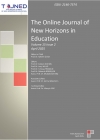TOJNED - Volume 3 - Issue 3 - July 2013
 Including Social Media Marketing With Gomc In An E-Business Course: A Preliminary Examination
Including Social Media Marketing With Gomc In An E-Business Course: A Preliminary Examination Nadira Alaraj
Abstract: An Online Advertising Campaign Project (OACP) based on Google Online Marketing Challenge of 2012 (GOMC12) was integrated into an E-Business course paradigm. GOMC12 incorporated social media marketing component using Google+ with AdWords, the keyword advertising application. One of the OACP goals was promoting awareness of the use of social media platforms in marketing in a novel collaboration between community organizations in Palestine and business studies students at Bethlehem University. Twelve online advertising campaigns were conducted with 12 participating organizations. A participatory action research (PAR) methodology was used to identify the challenges and opportunities of OACP process as part of an E-Business course and to find out how that could impact students knowledge and understanding. The findings of the study suggest that social media marketing and AdWords for participating in GOMC12 along with the E-Business course content proved somewhat overwhelming for the students, largely due to unanticipated challenges. Despite this finding, much was learned, providing strong evidence of the usefulness of this method in supporting student teamwork, understanding and sense of community engagement.
 Montessori Approach in Pre-School Education and Its Effects
Montessori Approach in Pre-School Education and Its Effects Ay├ģ┼Ėen├é┬Ā├āŌĆōZEREM,├é┬Ā├é┬ĀRahme├é┬ĀKAVAZ
Abstract: The aim of this study is to evaluate the efficacy of Montessori Method on pre-school children. The effect of the worldwide Montessori Approach, that is amongst many contemporary education methods, is studied at an institution in TRNC. The effect of this approach on social, cognitive and physical development of the children has been evaluated. The primary aim of Montessori approach is to enable the child explore him/herself and free that personality; thus, a convenient environment has to be set for the development of the child. How parents, teachers and pre-school institutions set such environments is also studied within this research. Additionally, the effect of the Montessori approach on children that is used by the teachers at school is also observed. The study, firstly, defines the following at the pre-school institution within the Montessori approach and then evaluates the effect of them on the children: ├óŌé¼┬ó Which principles are used├óŌé¼┬ó The role of the teacher├óŌé¼┬ó Tools used at school├óŌé¼┬ó The benefits The theoretical framework of this approach is drawn at an pre-school institution where this approach is implemented in TRNC.
 The Scale of Preservice Teachers├óŌé¼Ōäó Digital Pedagogic Competencies: Validity and Reliability Study
The Scale of Preservice Teachers├óŌé¼Ōäó Digital Pedagogic Competencies: Validity and Reliability Study Havva├é┬ĀYAMAN,├é┬Ā├é┬ĀZeynep├é┬Ā├ä┬░LER├ä┬░├é┬ĀAYDEM├ä┬░R,├é┬ĀTu├ä┼Ėba├é┬ĀDEM├ä┬░RTA├ģ┼Š
Abstract: Educators increasingly show interest to digital media that contains different learning styles and affects social and cultural aspects of children and young people. In our country, the relationship betweeen technology, pedagogy and teacher has gained importance within the scope of ├óŌé¼┼ōThe Movement of Increasing Opportunity in Education and Improving Technology├óŌé¼┬Ø (FATIH in Turkish) project of Ministry of National Education, which newly comes to the fore, related to active implementation of digital technologies in education. The education to be given within the scope of the project has been called digital pedagogy by researchers as it comprehends both digital information and pedagogy. The objective of the study is to develop a valid and reliable measuring tool in order to measure the competency of teacher candidates to use and create digital devices. When the measureing tool was developed, the courses to be given to teachers during the development of the measuring tool and the cases including digital pedagogy in literature were taken into consideration. Firstly, exploratory factor analysis was conducted for DPCS and a three factor structure that revealed % 55.6 of total variance was obtained. The structure acquired was tested with the exploratory factor analysis and model fit was tested through confirmatory factor analysis. As a result of the exploratory and confirmatory factor analyses, it was found that the model, which consisted of 19 items and three factors, was appropriate theoretically and statistically.
 Undergraduates Who Have a Lower Perception of Controlling Time Fail To Adjust Time Estimation Even When Given Feedback
Undergraduates Who Have a Lower Perception of Controlling Time Fail To Adjust Time Estimation Even When Given Feedback Yoshihiro├é┬ĀS.├é┬ĀOKAZAKI,├é┬Ā├é┬ĀTomoya├é┬ĀIMURA,├é┬ĀMasahiro├é┬ĀTAKAMURA,├é┬Ā├é┬ĀSatoko├é┬Ā TOKUNAGA
Abstract: Although there are many studies that have investigated the impact of time management, little research has examined empirically time management. The present study investigated the relationship between the perceived control of time scale and the degree of adjustment in repeated time estimation. Undergraduates were assigned to either an adjustment group or a no-adjustment group. The two groups were asked to estimate the time necessary to complete a task before each trial. The experimenter informed adjustment group participants of the time spent on the previous task before they made time estimates for the next trial. The noadjustment group participants were not informed of time spent on the previous task. The time estimation trial was repeated ten times. Results indicated that (a) only those in the adjustment group who had higher perceived control of time adjusted time estimates, (b) participants in the adjustment group with low perceived control of time and all participants in the no-adjustment group did not adjust their estimates. These results suggest that not only is it necessary to know the time spent on past tasks, but also it is necessary to have a high perceived control of time in order to adjust time estimates.
 The Role of Adequate Nutrition on Academic Performance of College Students in North Tripura
The Role of Adequate Nutrition on Academic Performance of College Students in North Tripura Santanu Ghosh, Haradhan Saha
Abstract: The development of a nation is closely interlinked with the education level of its population. Various studies have provided enough evidence of the importance of proper nutrition to the cognitive development of an individual which also affects their education achievements. Bur till date, the pathway as to how nutrition develops or hinders academic achievement is still not very clear. It has been established that poor health and malnutrition in early childhood may affect cognitive abilities. This study looks into the effect of nutritional on college students in North Tripura district which has hitherto not been documented earlier. The study shows that, the tribal students have lower BMI values than their nontribal counterparts which may be due to the tribal students having less access to convenience foods. Their poor nutritional status reflects in their academic achievements which are lower than their nontribal counterparts.
 Educational Technology: A Way To Enhance Student Achievement At The University Of Bahrain
Educational Technology: A Way To Enhance Student Achievement At The University Of Bahrain Jaflah Al-Ammary
Abstract: Educational Technology can empower teachers and learners, promote change and foster the development of twenty-first century skills. Improving education quality is a priority for most developing countries in which governments are facing a challenge to identify efficient ways to use their scarce resources and raise the quality of education. Data to support these beliefs are still limited, especially in the Kingdom of Bahrain and the other Gulf countries. Therefore, the current research aims to investigate the current situation regarding using Educational Technology at the University of Bahrain from the following aspects: the Educational Technology adopted by the university in the teaching and learning processes, obstacles facing the adoption of educational technology and the effects of Educational Technology on student achievement and academic staff teaching effectiveness. The results show that at the University of Bahrain, student learning and achievement have been affected when the teaching and learning processes are enhanced by Educational Technology. Educational Technology has motivated the students to get more involved in learning activities through which they become more active and more interested in learning. Moreover, the academic staff believe that adopting such technologies can enhance their communication with the students, reduce the teaching pressure caused by the course material preparation and make the lecture material available at the time of the discussion. However, the findings demonstrate some impediments facing both the students and instructors in adopting Educational Technology at the University of Bahrain, such as the insufficient ICT infrastructure and computing facilities, lack of sufficient technology budget and IT investment, and technical support.


